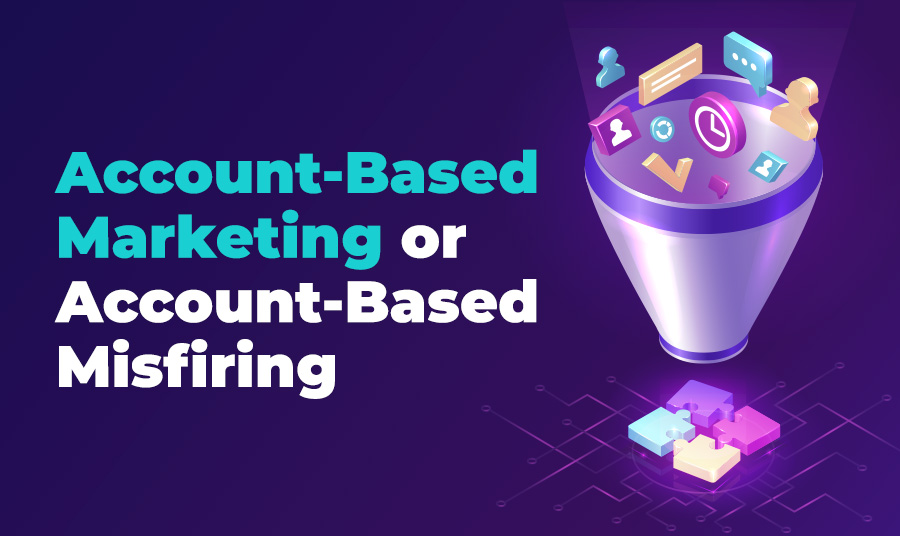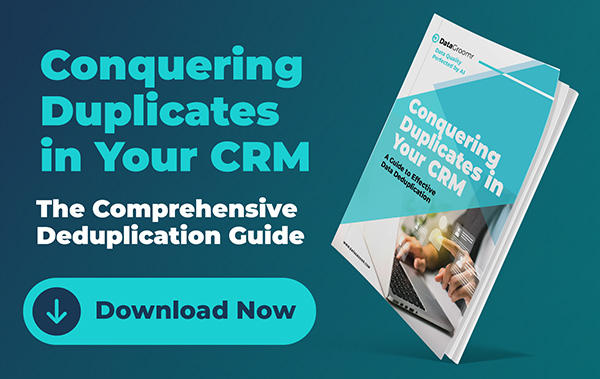
There’s a reason personalized marketing works. When you speak to your buyers about what they actually care about, it builds trust faster than any generic message ever could.
Successful account-based marketing campaigns can increase conversion rates so much it feels like magic. However, true ABM is much more than an email with your name in the subject line. It’s a hyper-personalized outreach strategy, spread across every touchpoint, designed to make your customers feel less like a number and instead like the only number.
But the promise of ABM can crumble if the foundation beneath it is broken. And nothing will damage your campaign faster than poor quality data.
The personalization that can charm cold prospects when it’s down well looks clumsy when it’s wrong.
A campaign that greets you by the wrong name or pitches you a product you’d never consider doesn’t feel like “personalization.” It feels irrelevant and clueless, and degrades the trust of your customers in your product.
Simply put, it’s garbage in, garbage out. Your ABM strategy needs to start with your data in order to be successful.
Why Broken Data = Broken Personalization
Every personalization effort is only as good as the data beneath it. The truth is, that data is often messy.
Salesforce’s own study found the average customer database has 90 percent incomplete records. The same study found that one in five contacts is junk: duplicates, outdated emails, or ghost accounts left over from acquisitions, mergers, or churned employees.
If your data isn’t clean, personalization becomes a gamble.
Beyond the [Insert First Name] Approach
Personalization is hardly new. It’s been 20 years since email tokens made a name inserted in an email subject line feel personal and authentic. Yet when most people think of personalization, they picture an email. But ABM is bigger than an inbox.
It’s a LinkedIn InMail from a sales rep, a targeted ad in your feed, a hand-written postcard showing up in your office. It can also be a conversation at a conference booth or a sequence of phone calls that feel informed and not like a blatant cold call.
Each of those touchpoints relies on accurate, clean data to land the right way. A misspelled name in an email is embarrassing. The wrong job title in a LinkedIn message feels careless. Sending a direct mail piece to someone who left the company months ago or digital ads that chase the wrong contact across the internet only burn more money.
Personalization is a string of signals across every channel. The data underneath keeps them united and accurate.
Why Salesforce Gets Polluted
Your Salesforce data didn’t start broken. Polluted data creeps in during dozens of routine tasks and happens to almost every company with a sizable Salesforce database.
It starts with a typo here or a sloppy import there. “Sarah Johnson” becomes “Sara Jonson.” Microsoft fractures into “MSFT,” “Microsoft Corp,” “Microsoft Corporation,” and five other variants.
Acquisitions pour duplicate records into the system. Integrations bring in inconsistent job titles. Sales blames marketing while marketing blames sales. In between the finger-pointing, no one owns the clean-up.
The Cost of Looking Stupid
Your prospects don’t care that it was a Salesfoce a glitch that caused them to receive misaligned marketing. They just know you got it wrong.
The financial impact adds up fast. There’s the cost of missed opportunities, and the real cost of sending targeted marketing to the wrong people.
Imagine spending tens of thousands on ads, only to target a company that no longer exists because it was absorbed in a merger. You may write a perfectly carefully crafted email, but it lands in the inbox of the junior coordinator instead of the decision-maker, and never sees the light of day.
Each misfire costs time, effort, and ad spend while also eroding credibility that can be nearly impossible to rebuild.
Clean Data, Real Impact
As much as bad data threatens to erode your efforts, the reverse is true when your Salesforce instance is well-maintained.
Companies with disciplined CRM hygiene see 30 percent more ABM pipeline contribution and cut acquisition costs by 15 percent, according to a Boston Consulting Group study.
It may sound like magic, but it’s really just a byproduct of a healthy campaign. When your intelligence is accurate, every touchpoint builds up trust instead of draining it.
Any company that wants to invest in ABM strategies needs to first invest in the unglamorous work of data hygiene first.
It won’t win awards or get mentioned in a splashy press release, but it’s the difference between ABM success and ABM misfiring.

Personalization and Privacy
Of course, not every customer welcomes personalized campaigns. If your campaign makes use of data that they don’t want out, it can easily feel like an intrusion. The line between helpful and creepy can be fragile, and bad data only makes that more delicate.
A prospect who receives an on-point message might feel understood. Yet a different prospect who receives a mis-targeted one might wonder what else you know about them or why you got it wrong. In a world where data breaches and privacy laws can hijack headlines, sloppy personalization can appear hazardous.
That’s why the foundation matters. Clean, transparent data practices make campaigns more effective while also signaling respect. They show your audience that you know enough to be relevant without overstepping into surveillance. In the long run, that respect is the only path to durable trust.
Measuring What Matters
Companies love to talk about personalization in lofty terms: delight, connection, trust. But when budgets are under scrutiny, the conversation shifts. What’s the return? What’s the impact on pipeline, on revenue, on the cost of acquiring a customer?
Here’s the good news: the link between clean data and measurable ABM success is well documented.
Companies that maintain accurate, unified CRM records will consistently see stronger results across every key metric. Pipeline contribution from marketing increases because your campaigns reach the right people. When the messages are relevant to decision-makers in the right industry, your conversion rates will improve. Customer engagement climbs because the outreach feels thoughtful and personal. Acquisition costs drop when dollars aren’t wasted chasing phantom accounts.
Here are three key metrics to consider:
Reply Rates: Look at reply rates. One study from Outreach.io found that when job titles don’t align with buyer personas, response rates fall by as much as 40 percent. That can be the difference between pipeline momentum and a dead end quarter. With accurate data, you can flip the script. Those reply rates bounce back for you, feeding your funnel qualified opportunities.
Cost efficiency: Disciplined data hygiene can cut customer acquisition costs by significant margins. Every ad dollar you spend and hour your SDRs spends will stretch further if it’s aimed at the right target. You stop wasting money on ad impressions you don’t need or marketing to duplicate accounts.
Retention: Customers who experience misfires early in the buying journey tend to be less likely to renew. If your retention figures are suffering, it’s time to examine the first year of your customer’s relationship with you. Is it riddled with wrong names, irrelevant offers, or tone-deaf touches? The brand damage from those first impressions linger. Yes, clean data improves acquisition, but it also compounds over time, lifting customer lifetime value and reducing churn.
Here’s one clear lesson: ABM without clean data drains budget while delivering little. Campaigns look polished, but don’t produce results. With clean data, ABM turns into a reliable growth engine. The metrics tell the story. You’ll see a stronger pipeline, with higher conversions, and improved retention.
And unlike clever creative or the latest martech integration, these gains aren’t fleeting. They’re structural. They last as long as your data stays clean.
Personalization is a mirror. If your Salesforce instance is polluted, it won’t hide your problems, it will magnify them.
In the end, you don’t get to decide whether you’re personalizing well. The prospect does. And if your data is dirty, the judgment will be swift.










